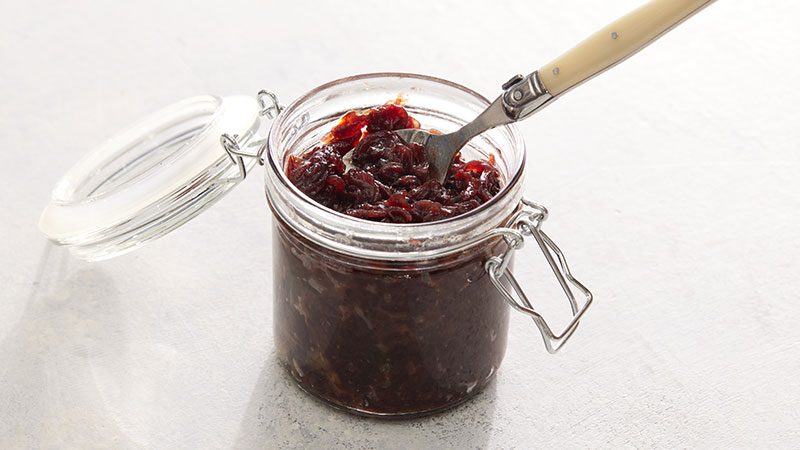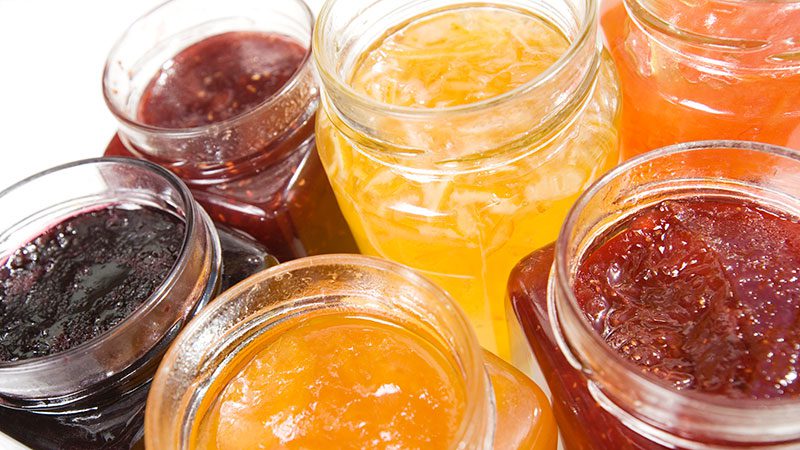Jam vs. Jelly vs. Spreads: Know Your Fruit Spreads

Don’t offer to make Audra Query Lawlor’s young son a peanut butter and jelly sandwich. Not if you’re using a jar from Girl Meets Dirt, the brand of jam Lawlor has been making on Orcas Island since 2013. It’s not the flavor her son objects to—it’s the nomenclature. Even he knows, says Lawlor. “We don’t make jelly.”
No matter what you call them, jelly, jam and preserves all began as a pre-electricity cheat code so people could stockpile the charms of fresh fruits beyond the summer season. The iterations get even more confusing when you throw in variations like compote, conserves, chutney, or marmalade (or the intentionally vague “fruit spread,” a common sight on jar labels).
These terms all represent some combination of fruit, sugar, acid, and heat. The final product gets a significant gelling assist from pectin, vividly described by Serious Eats as “a molecular web that holds all of the fruit’s juices together.” Some fruits are naturally high in pectin, but it can be added separately too.
What is a Jam?
The distinction between jelly and jam is clear—and also, liquid. Jelly’s defining characteristic is that it’s made with fruit juice, rather than with chunks of whole fruit. Thus, jelly usually has a smoother texture than jam, preserves, and their ilk. In the Blue Chair Jam cookbook, Rachel Saunders defines jelly as “an extracted fruit juice that has been combined with sugar, lemon juice, and (sometimes) added pectin and boiled until it sets.”
Jelly often gets a bad rap, thanks to some low-quality commercial versions. But in her book, Saunders observes there’s beauty to a homemade jelly. The classic process involves reducing large amounts of fruit into a strained juice, a potent concentration of liquid fruit flavor. It’s no small amount of labor, but the resulting jelly, she writes, has “a complex taste that may contrast sharply with its perfectly smooth texture.”
What Is the Difference Between Jam and Preserves?
Simply put, jam contains chunks of real fruit, whether it’s chopped, crushed, pureed until almost smooth—or left practically whole if we’re talking about smaller berries.
“Jam and preserves are totally synonymous in my book,” says Girl Meets Dirt’s Audra Lawlor. Preserves tend to have bigger, more visible chunks of fruit than jam, but there’s no formal rule on this. She chose the term “preserves” for her jars—which come in flavors like rhubarb lavender, pear balsamic, and shiro plum with mint—because it felt more appropriate given the handmade nature and chunky texture within.
While producers are loose with formal names, the U.S. Food and Drug Administration (FDA) actually has a legal definition for jam and preserves that involves the ratio of fruit to sugar. Make a jam with multiple fruits—maybe throw in some additional items, like nuts or dried fruit—and, boom: Your jam also technically qualifies as a conserve.

What Is a Compote?
Compote generally shows up in desserts rather than at breakfast or lunch. It’s fruit, cooked over low heat in a sugar syrup so the pieces stay well intact. In her nifty food reference book, What’s the Difference, Brette Warshaw describes compote as a close cousin to jam, but “unlike preserves—which are usually jarred for future use—compote is used straight away.” The all-knowing scribes at MasterClass say compote has less sugar than your typical jam and is harder to spread.
What About Marmalade, Confiture, and Chutney?
If you’re preserving with citrus fruit, you’re probably making a marmalade. However, there are two camps for the formal definition. One, laid out in The Blue Chair Jam Cookbook, classifies marmalade as “a jelly with clearly defined pieces of fruit suspended in it.” Traditional jelly making, of course, is a metric ton of work. So marmalade has a more accessible alter ego as a preserve, always made with pectin-rich citrus rinds as well as the flesh within.
The Food 52 site regards preserves as “the middle child of the fruit spread family,” not as even-textured as jam, but less fussy a confiture, which suspends whole or sliced fruit within its own syrup. Bow Hill, a blueberry farm in the Skagit Valley (see its original story here), makes a beautiful confiture with its Bluecrop variety.
Orbiting in the more spice-forward, sometimes savory realm of fruit preserves is this chunky condiment with origins in India. Over at Sukhi’s Gourmet Indian Foods, the official stance is that any fruit or vegetable preserved in sugar and vinegar can qualify as a chutney.
How Do You Make Fruit Butter?
Apple butter is the most common example, but generally this branch of the preserve family does its own thing. Combine sugar and your fruit of choice (maybe some spices), slow cook it for hours and you get a thick, spreadable paste that’s smooth with a creamy consistency, albeit no actual dairy. A Seattle resident could road trip to San Francisco during the cook time of this fruit butter recipe from Creative Canning, though other recipes are closer to 3 hours, or even less.
Fruit butters generally contain less sugar than their jelly, jam, and preserve brethren, and no additional pectin, since the thickness comes from liquid evaporating during that long, slow cook.
